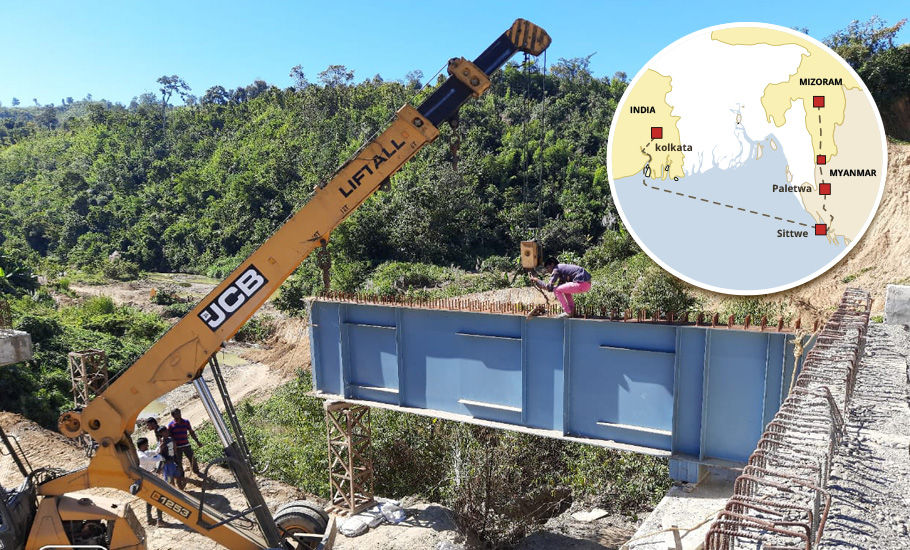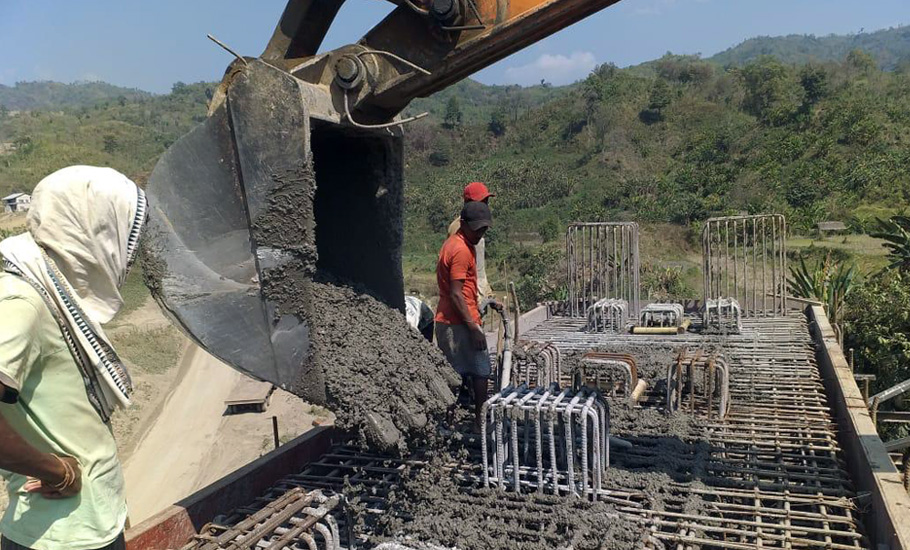
- Home
- News
- Analysis
- States
- Perspective
- Videos
- Education
- Entertainment
- Elections
- World Cup 2023
- Features
- Health
- Business
- Series
- Economy Series
- Earth Day
- Kashmir’s Frozen Turbulence
- India@75
- The legend of Ramjanmabhoomi
- Liberalisation@30
- How to tame a dragon
- Celebrating biodiversity
- Farm Matters
- 50 days of solitude
- Bringing Migrants Home
- Budget 2020
- Jharkhand Votes
- The Federal Investigates
- The Federal Impact
- Vanishing Sand
- Gandhi @ 150
- Andhra Today
- Field report
- Operation Gulmarg
- Pandemic @1 Mn in India
- The Federal Year-End
- The Zero Year
- Premium
- Science
- Brand studio
- Home
- NewsNews
- Analysis
- StatesStates
- PerspectivePerspective
- VideosVideos
- Entertainment
- ElectionsElections
- Sports
- Loading...
Sports - Features
- BusinessBusiness
- Premium
- Loading...
Premium

How Myanmar coup threatens to spoil India’s Act East dream
The military coup in Myanmar and subsequent mass unrest has threatened India's Kaladan connectivity project between Northeast and Bengal via Sittwe port.

Rattling and clattering of concrete mixture, pounding of hammers and howling of men and machine at work at a secluded forest area near India-Myanmar border in Mizoram kindle hopes of undoing a travesty of history. The work in progress is for the construction of a bridge over a hill stream for an 87.18 km-long border road to connect Mizoram’s south-eastern district of Lawngtlai with...
Rattling and clattering of concrete mixture, pounding of hammers and howling of men and machine at work at a secluded forest area near India-Myanmar border in Mizoram kindle hopes of undoing a travesty of history.
The work in progress is for the construction of a bridge over a hill stream for an 87.18 km-long border road to connect Mizoram’s south-eastern district of Lawngtlai with neighbouring country Myanmar.
It entails construction of eight bridges and 428 culverts on the stretch of the road.
As of February this year, 75 percent of the work for the construction of bridges and over 90 percent road-laying work were completed.
The connectivity project is part of the ambitious $484 million Kaladan Multi Modal Transit Transport Project (KMMTTP) undertaken to uncork the bottleneck in northeast India created by India’s partition.
The project aims to connect the landlocked northeastern region with mainland India through sea, river and road. It proposes to connect Haldia port near Kolkata with Sittwe seaport in Rakhine state of Myanmar through the Bay of Bengal.
It will then link Sittwe seaport to Paletwa port in the neighbouring country’s Chin State via the Kaladan river boat route, and then from Paletwa by road to Mizoram. The NH-54 will connect further to Assam and other states of the region.
The route will cut the distance from Haldia port to Lawngtlai in Mizoram by almost half. Through the Siliguri Corridor (near Darjeeling), the distance is 1,880 km. The Kaladan project will cut it down to 950 km.
The idea to provide a trans-national connectivity to the region through Myanmar was mooted way back in the late 1960s.
Bangladesh was then East Pakistan. Connecting the strategically sensitive Northeast—the epicentre of the India-China war of 1962—through Pakistan’s territory was out of contention.
The war with China had intensified the threat perception to the region’s only land link with the rest of India through the 22-km wide ‘Siliguri Corridor’, commonly called the ‘Chicken’s Neck’.
It was this security concern that led the then Prime Minister Indira Gandhi to consider the alternate route to the Northeast through Myanmar.
Birth of Bangladesh and geopolitical churn
Within years of mooting the idea, geopolitics in India’s eastern neighbourhood underwent a sea change following the emergence of Bangladesh as an independent nation with the help of military intervention from India.
The birth of Bangladesh opened up the easier option of connecting the Northeast by reviving pre-partition rail, road and ports linkage with the nascent country.
The assassination of Sheikh Mujibur Rahman and the subsequent military coup in Bangladesh within years of its birth, however, completely changed the scenario, with Bangladesh becoming increasingly non-cooperative towards India.

It was only after Mujibur Rahman’s daughter Sheikh Hasina Wazed became the Prime Minister of Bangladesh in 1996 that Dhaka again started getting closer to New Delhi.
The return of Khaleda Zia-led Bangladesh Nationalist Party government in 2001 cut short the bonhomie between the two neighbours, only to be revived again after the landslide victory of Hasina’s pro-India Awami League in 2008.
In the meantime, pro-China drift of Myanmar’s military regime also rendered Indira Gandhi’s proposal of connectivity through Myanmar unviable.
In this geopolitical flux since the 1947 Partition, the connectivity to India’s remote Northeast had been a casualty.
India again turned to Myanmar to open up its northeastern region after the PV Narasimha Rao government in 1991 came up with India’s Look East policy to offset China’s growing strategic influence in Southeast Asian countries.
The policy, now rechristened as ‘Act East’, made Northeast India’s gateway to Southeast Asia, necessitating a major revamping of connectivity linkage of the region.
Military junta and Indian govt
It was during Rao government that India started reversing its stand against Myanmar’s military junta by distancing itself from the pro-democracy movement in that country, giving preference to ‘pragmatism’ over idealism.
After prolonged deliberations, the project’s framework was laid down only on April 2, 2008, in a joint protocol signed by the two countries. The project was scheduled to be completed by 2014. But it kept getting delayed due to disturbance in and around the project sites in Myanmar.
Ethnic Arakans and Rohingyas are waging insurgent warfare in Rakhine state where the Sittwe port is located, while the route of the project around Paletwa is disturbed with Chin conflict.
The Arakan Army, one of the largest insurgent groups of Myanmar, intensified its hostility since 2019 just as some phases of the Kaladan project were nearing completion.
Some major components of the project, including rebuilding and capacity enhancement of the Sittwe Port, river dredging and Paletwa jetty construction have been completed, according to a progress report of the project.
External Affairs Minister S Jaishankar, during a visit to Guwahati last month, said the multi-modal trans-national connectivity project was in the final stages of completion, exuding hope that the current turmoil in neighbouring Myanmar would not hamper the progress of the project.
The ground situation in Myanmar, however, belies the optimism. The February 1 military takeover in the country triggered a massive unrest in Myanmar, casting a shadow of uncertainty on the project.

Stability in Myanmar is the prerequisite for the success of the Kaladan project, opined former Bangladesh diplomat Tariq Karim and a strategic affairs expert Lt General (Retd) Subrata Saha. They were talking at a virtual conference organised by the Observer Research Foundation on March 5-6 on ‘Exploring Connectivity in the Bay of Bengal Region: Importance of India’s Northeast’.
Chinese connection
What appears to be more alarming is the alleged Chinese connection in the latest development in Myanmar that has now triggered an influx of refugees into Mizoram.
Already 48 people have taken refuge in the northeastern state, according to a conservative estimate of the Mizoram government.
Another about 100-plus Myanmar nationals are said to be waiting on the border to get entry into India. Among them are many family members of the leaders of the Chin National Army, an ethnic insurgent group.
Among those who have already entered India are eight policemen, who are wanted by the Myanmar military for defying orders.
Myanmar has placed a request with India to hand over the “fugitive” policemen to “uphold friendly relations between two neighbours”.
The predicament for New Delhi is to whom to side with in the current turmoil—the military regime or the people. Either way, the tilt is fraught with risk.
The challenge for India will be to keep the junta in good humour without upsetting the pro-democracy forces, a balancing act on which the future of Northeast’s connectivity through Myanmar will depend.

